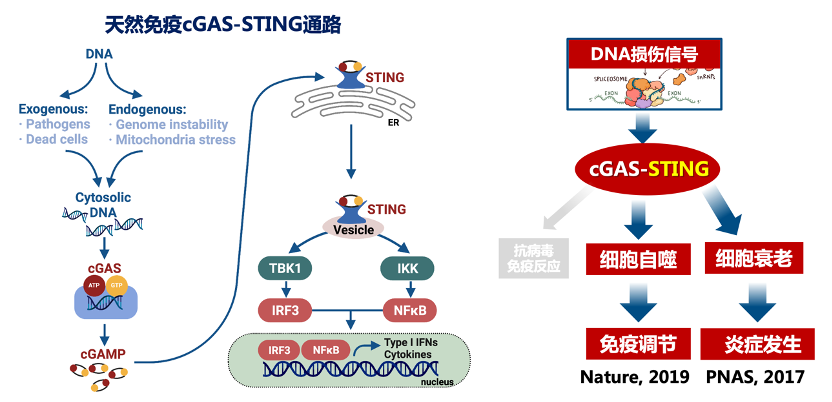
The cyclic-GMP-AMP synthetase (cGAS) pathway is a recently discovered important antiviral pathway. It is known that cGAS binds to viral DNA, produces cGAMP, activates STING, and induces the production of type I interferon, thereby resisting the virus. In addition, this pathway is also involved in the regulation of various physiological functions. It has been reported that cGAS is involved in new non-virus-dependent physiological processes such as cell senescence and autophagy.
1.1 The cGAS-STING pathway regulates cellular senescence
In immortalized mouse embryonic fibroblast and DNA damage-induced senescence model, it was first confirmed that cGAS activates the downstream pathway by binding to damaged DNA in micronuclei. More importantly, the cGAS-STING pathway regulates cell senescence by manipulating the generation of senescence-associated secretory phenotype (SASP). These results were published in the international core journal PNAS in 2017. This study expands the physiological and pathological significance of the cGAS-STING pathway, suggesting that regulating cGAS activity is expected to become a new strategy for the treatment of aging-related diseases. This work has been recommended by Nature, Immunity and Nature cell Biology at the same time, and was selected as a highly cited paper by Web of ScienceTM, and was subsequently confirmed by Nature and Nature cell Biology papers.
1.2 The cGAS-STING pathway regulates autophagy.
cGAS catalyzes cGAMP production, which further activates the ER adaptor protein STING. Our study is the first to report the conserved function of the cGAS-STING pathway regulating autophagy. Our study found that the second messenger molecule cGAMP activates STING, on the one hand induces STING to migrate from the endoplasmic reticulum to the ER-Golgi intermediate compartment (ERGIC) through COP2, and then to the Golgi, endosome and lysosome , to induce autophagy. On the other hand, STING in ERGIC acts as a lipid membrane provider and directly participates in autophagy. It was confirmed that STING lack of C-terminus(deletion-induced interferon activity) can also be activated to induce autophagy, and it was proved that cGAS-cGAMP-STING regulation of autophagy is an evolutionarily conserved function, earlier than the induction of interferon in this pathway. This study shows that autophagy-related regulation is a new direction to regulate the function of cGAS-cGAMP-STING pathway. This achievement was published in the international core journal Nature in 2019, and this work was highlighted by Nature Immunology and Nature Reviews Genetics. It is believed that this study reveals that autophagy is the main primordial function of the cGAS-STING pathway.